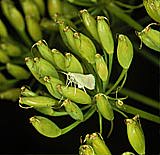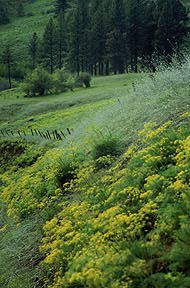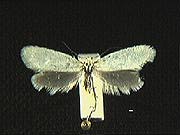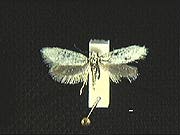Greya subalba
Olle PellmyrAdult Characteristics
Wing expanse 11-16 mm. Forewing uniformly white (male) to yellowish white (female). Hindwind light gray, somewhat darker than the forewing.
Comparison with Similar Species
Occasional males of G. solenobiella may very rarely be so light as to cause confusion. The two species show very little, if any, overlap in current range. Tetragma gei coexists with the species in some areas, and is superficially similar; differences are listed under that species.
Host, Oviposition, and Larval Feeding Habits
Feeds on several species of Lomatium (Apiaceae). The female cuts and oviposits into young fruits, and the larva feeds on the developing seeds for the first one or two instars. The life history of later stages is unknown.


Female ovipositing into Lomatium dissectum fruit.
Geographic Distribution
Known from drier portions of southern British Columbia and Alberta in Canada. It is common in interior Washington and Oregon, northern Idaho, and western Montana, and may occur as far south as southwestern Oregon.
Habitat
In dry, forb-rich steppe with Lomatium. Elevational range, 200-1650 m.


Typical habitat with Lomatium grayi, in Nez Perce Co., Idaho.
Ecological Notes
Thompson (1986, 1987) used G. subalba and a braconid parasitoid as a model system to explore the evolution of egg dispersal strategies in herbivores using discrete food patches and evolution of host search behavior in their natural enemies.
References
Davis, D.R., O. Pellmyr & J.N. Thompson. 1992. Biology and systematics of Greya Busck and Tetragma n. gen. (Lepidoptera: Prodoxidae). Smiths. Contrib. Zool. 524:1-88.
Thompson, J.N. 1986. Oviposition behaviour and searching efficiency in a natural population of a braconid parasitoid. J. Anim. Ecol. 55:351-360.
Thompson, J.N. 1987. Variance in number of eggs per patch: oviposition behaviour and population dispersion in a seed parasitic moth. Ecol. Entom. 12:311-320.
Title Illustrations

| Scientific Name | Greya subalba |
|---|---|
| Location | Whitman Co., Washington, USA |
| Specimen Condition | Dead Specimen |
| Sex | Male |
| Image Use |
 This media file is licensed under the Creative Commons Attribution-NonCommercial License - Version 3.0. This media file is licensed under the Creative Commons Attribution-NonCommercial License - Version 3.0.
|
| Copyright |
© 1996

|
| Scientific Name | Greya subalba |
|---|---|
| Location | Whitman Co., Washington, USA |
| Specimen Condition | Dead Specimen |
| Sex | Female |
| Image Use |
 This media file is licensed under the Creative Commons Attribution-NonCommercial License - Version 3.0. This media file is licensed under the Creative Commons Attribution-NonCommercial License - Version 3.0.
|
| Copyright |
© 1996

|
About This Page

University of Idaho, Moscow, Idaho, USA
Page copyright © 1996
 Page: Tree of Life
Greya subalba .
Authored by
Olle Pellmyr.
The TEXT of this page is licensed under the
Creative Commons Attribution-NonCommercial License - Version 3.0. Note that images and other media
featured on this page are each governed by their own license, and they may or may not be available
for reuse. Click on an image or a media link to access the media data window, which provides the
relevant licensing information. For the general terms and conditions of ToL material reuse and
redistribution, please see the Tree of Life Copyright
Policies.
Page: Tree of Life
Greya subalba .
Authored by
Olle Pellmyr.
The TEXT of this page is licensed under the
Creative Commons Attribution-NonCommercial License - Version 3.0. Note that images and other media
featured on this page are each governed by their own license, and they may or may not be available
for reuse. Click on an image or a media link to access the media data window, which provides the
relevant licensing information. For the general terms and conditions of ToL material reuse and
redistribution, please see the Tree of Life Copyright
Policies.
Citing this page:
Pellmyr, Olle. 1996. Greya subalba . Version 01 January 1996 (under construction). http://tolweb.org/Greya_subalba/12329/1996.01.01 in The Tree of Life Web Project, http://tolweb.org/










 Go to quick links
Go to quick search
Go to navigation for this section of the ToL site
Go to detailed links for the ToL site
Go to quick links
Go to quick search
Go to navigation for this section of the ToL site
Go to detailed links for the ToL site